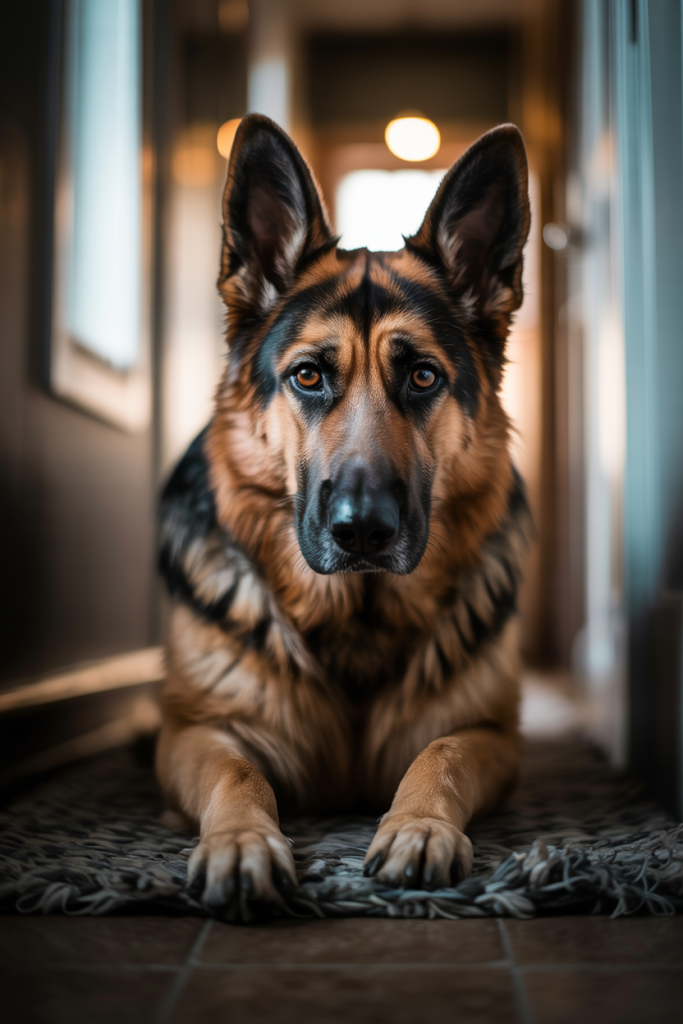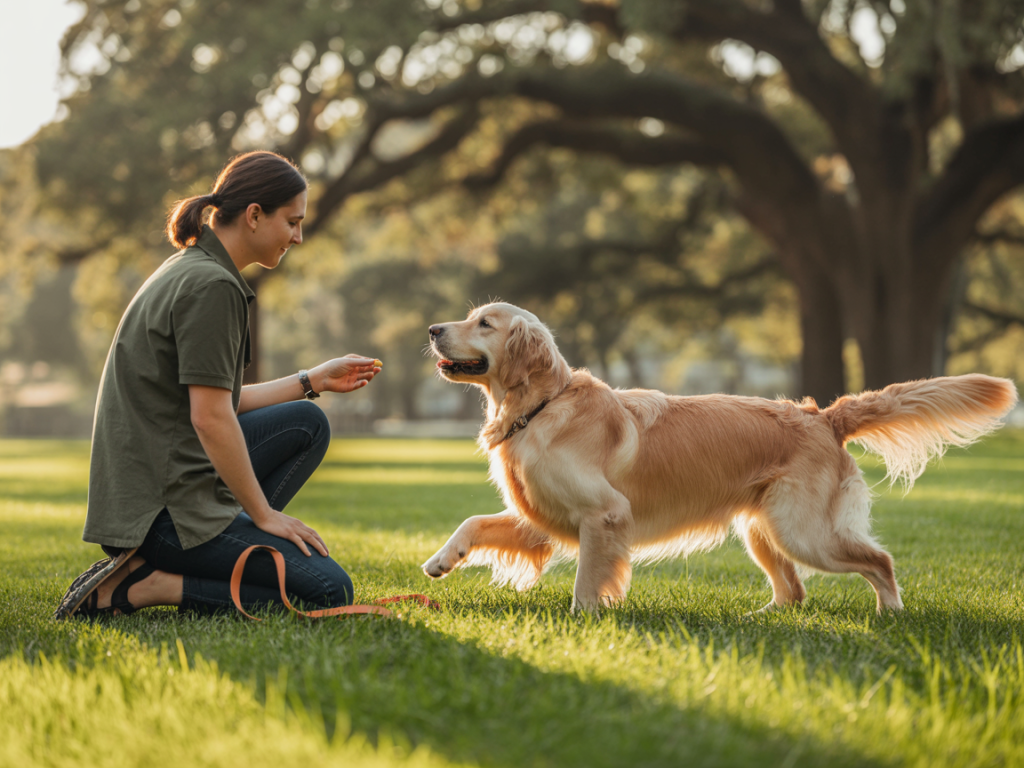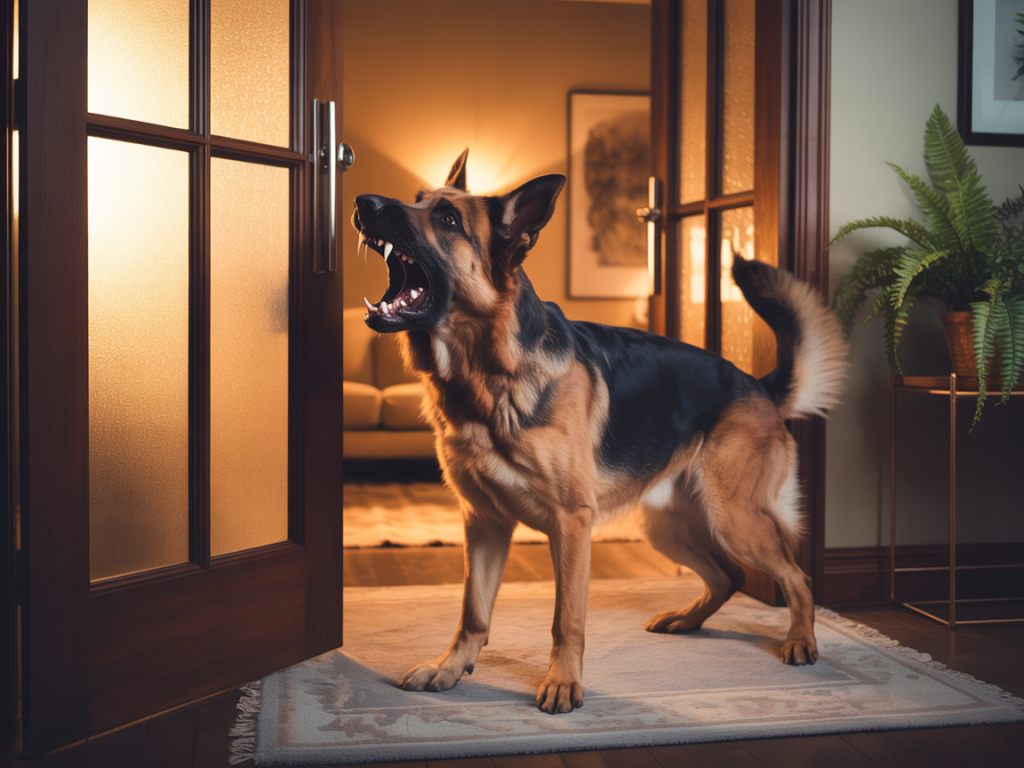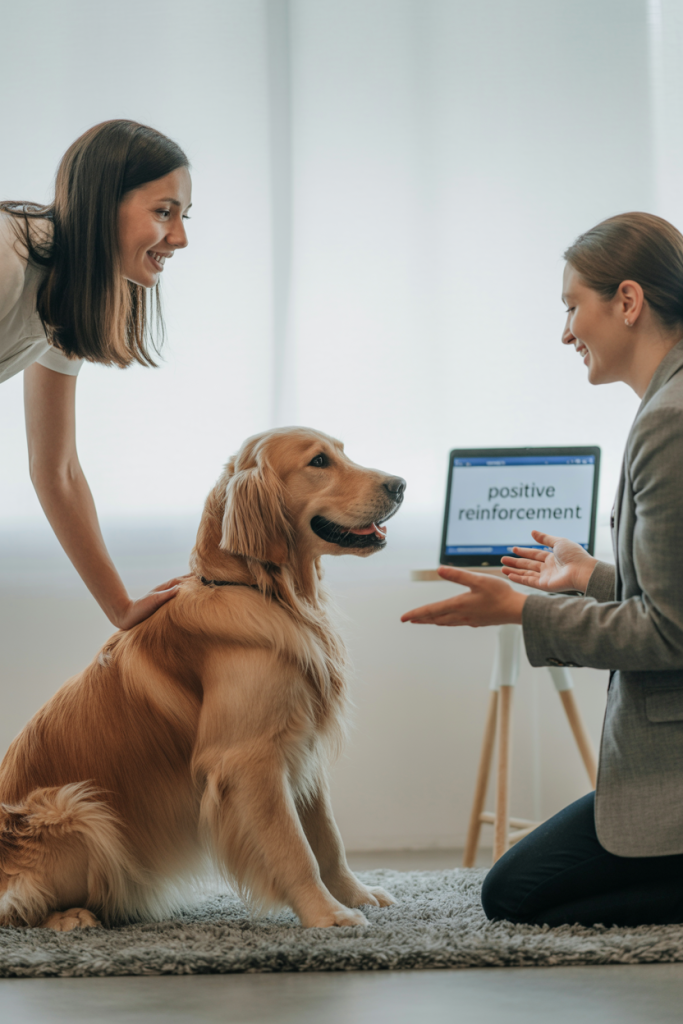Few things stop your heart faster than seeing your dog growl, bark like mad, or snap at someone you love. One moment you’re cuddling on the couch, and the next — boom — your sweet pup is lunging at the front door like a furry missile. It’s scary. It’s confusing. And it makes you wonder, “Where did that come from?”
But here’s the truth: an “angry” dog isn’t a bad dog. It’s a dog trying to tell you something — and maybe you just haven’t learned their language yet.
Let’s unpack what might really be going on behind the growls, and how you can help your pup feel safe, calm, and understood again.

Why Do Dogs Get Angry?
Despite what it might look like on the surface, dogs don’t just wake up angry one day. What we call “aggression” is usually just the tip of an emotional iceberg — fear, confusion, frustration, pain. Underneath the barking is a brain trying to cope with something it doesn’t fully understand.
So what’s behind the behavior?
Let’s take a look at a few usual suspects:
Fear and anxiety
Think of a dog like a nervous kid on the first day of school — unsure, alert, overwhelmed. Rescue dogs especially may carry past trauma that makes them quicker to react.
Territorial instincts
Some dogs guard their food, toys, or favorite human like a dragon with treasure. It’s not about being “mean” — it’s about survival instincts kicking in.
Frustration overload
A dog cooped up all day with no outlet for energy? That’s a recipe for a meltdown. Without structure and stimulation, frustration boils over.
Pain or health issues
If your dog suddenly gets snappy, a vet visit should be your first stop. An achy back or toothache can turn even the gentlest pup into a grump.
Lack of socialization
Dogs that missed key social experiences as puppies may struggle to interpret other animals — or humans. They default to defensiveness because they don’t know what else to do.
The bottom line?
An “angry” dog is usually just a misunderstood dog. And when we learn to see the world from their paws, we can help them feel safer in it.
For more on common causes of aggression, the American Kennel Club offers a helpful overview of behavior types and triggers.
How to Read the Warning Signs of an Angry Dog
Dogs aren’t sneak attackers — they give you a heads-up. But the signs are often subtle, and many owners accidentally ignore them until things escalate. Learning your dog’s body language is like reading subtitles in a foreign movie: once you know what to look for, the whole story changes.
Key Body Language Signals
Dogs don’t talk with words — they speak with their whole body. And when they’re upset, it shows:
Stiff posture
If your dog suddenly goes still, like someone hit “pause,” pay attention. That frozen body is full of tension.
The hard stare
This isn’t a playful glance. If your dog locks eyes and doesn’t blink — especially with a closed mouth — that’s a red flag.
Raised hackles
You know that ridge of fur down your dog’s back? When it’s standing up like a mohawk, your dog is on high alert.
Low growl
A quiet growl is a warning, not a challenge. It’s your dog’s way of saying, “Please back off.”
Tail talk
A stiff, high tail can mean, “I’m ready to stand my ground.” A low, tucked tail says, “I’m scared.” Both deserve your attention.
What About Barking?
All dogs bark — but how they bark matters. A high-pitched, frantic yapping usually means alarm. A low, slow bark is more like, “Hey, back off.” Learn the rhythm, and you’ll learn what they’re feeling.
(And yes, we’ve all had the experience of our dog barking wildly at… absolutely nothing. Sometimes they just like to keep us on our toes.)

Whatever You Do, Don’t Punish the Warning
Here’s the most important piece: if your dog growls or barks a warning, thank them for it. (Not literally — but definitely don’t punish them.)
Why? Because when you punish a growl, you’re removing the warning system. That dog might still feel uncomfortable next time — but now they’ll skip the warning and go straight to snapping.
Instead, think of it like this: your dog just handed you a clue. Now it’s your turn to solve the puzzle. What triggered it? How can you change the environment or give them more space?
Your goal isn’t just to stop the growling. It’s to create a home where your dog doesn’t need to growl in the first place.
Creating a Safe and Calm Environment at Home
A reactive or “angry” dog can’t find peace in a chaotic space — and honestly, can you blame them? Just like us, dogs need a calm, predictable environment to feel grounded. Before you even think about training, it’s worth asking: Does my home help my dog feel safe… or stressed out?
Your dog’s surroundings can either soothe their nervous system or light a fuse. Let’s stack the odds in their favor.
Routine Brings Confidence
Dogs love knowing what’s coming next. A predictable routine — meals at the same time, daily walks, rest, play, and training windows — gives your dog a sense of control in their world.
Ever notice how a dog perks up right before their usual walk time? That’s routine working its magic. On the flip side, long hours alone or random, noisy chaos can crank up anxiety — which often shows up as growling, barking, or snapping.
Structure isn’t boring to a dog. It’s freedom through stability.
Use Space Wisely
Here’s a secret: even the most affectionate dogs need alone time. Especially if they’re feeling overwhelmed or reactive.
Think of it like their own reading nook — not a “timeout” zone. A safe space where no one bothers them, the energy is low, and they can just be.
One of the best solutions? Dog crate furniture.
Forget those cold wire crates — today’s crate furniture blends right into your living room and gives your pup a cozy den that feels like home. It’s a little sanctuary they can escape to when the world feels too loud.
If your dog starts choosing that spot on their own, you’ve done it right

Small Adjustments That Make a Big Difference
Want to create a calmer home vibe for your pup? Start here:
- Keep noisy zones quieter during meals and nap time.
- Cut down on slamming doors and shouting — even upbeat chaos can overwhelm sensitive dogs.
- Try calming music or white noise (yes, Spotify has dog playlists now!).
- And remember: if your dog walks away from a situation, let them. Forcing social time never ends well.
Once your dog starts to feel emotionally safe at home, they’ll be much more open to learning, trusting, and changing old habits.
Dog Training Methods to Reduce Aggression
Here’s the truth: training a reactive or aggressive dog isn’t about “fixing” them. It’s about helping them feel safe enough to respond differently — to replace fear with trust, and instinct with choice.
An angry dog isn’t being “bad.” They’re doing the only thing they know to feel in control. Training gives them new options — and that’s where the magic happens.
Positive Reinforcement: Reward the Calm Moments
You’ve probably heard this a hundred times, but it’s worth repeating: dogs do more of what works for them. And if staying calm gets them treats, praise, or belly rubs? That becomes their new go-to move.
The American Veterinary Society of Animal Behavior strongly advocates for reward-based methods over punishment, especially for aggressive or fearful dogs.
Let’s say your dog usually lunges at the window when someone passes by. But today, they just watch quietly for a moment. That’s your moment. Reward that calm behavior like they just passed a final exam.
A few real-life examples:
- Your dog sees another dog on a walk but looks at you instead of barking? Jackpot — treat and praise.
- Someone rings the doorbell, and your dog pauses instead of losing it? That pause is gold.
- Your dog sits when they used to jump? That’s progress, and it deserves a party.
You’re reinforcing the behavior you want to see more of. Not silencing them — guiding them.
Counter-Conditioning: Rewire Their Reactions
This one’s like emotional judo. You’re not overpowering their instinct — you’re flipping the script.
Say your dog reacts badly to skateboards, other dogs, or even the vacuum. With counter-conditioning, you start at a distance where your dog notices the trigger but doesn’t react. Then you shower them with good stuff — high-value treats, toys, praise.
Little by little, their brain rewires:
“Oh hey, that weird thing = chicken! Maybe it’s not so scary after all.”
Over time, you can slowly reduce the distance and build up their confidence. It takes consistency and patience — but it works.

Puppy Training: Start Early, But It’s Never Too Late
If you’ve got a puppy? You’ve hit the jackpot.
Early socialization and training are like setting a GPS for your dog’s emotional future. Introduce them to sounds, smells, textures, people, other dogs — all in a safe, positive way.
They learn the world is a place to explore, not fear.
But even if your dog’s past that stage — don’t worry. Older dogs can absolutely learn new tricks. It just might take a little longer, and a little more love.
What Not to Do (Seriously, Don’t)
Let’s get this out of the way. These common reactions might feel natural in the moment, but they do more harm than good:
- Yelling or hitting: All this teaches your dog is fear. Fearful dogs don’t get calmer — they just shut down or explode.
- Inconsistent rules: If one person lets the dog on the couch and another scolds them for it, your dog will stay confused (and anxious).
- Punishing growling: Remember — a growl is a warning, not a betrayal. If you take away the warning, you might get a bite without notice.
Instead, think of yourself as a guide, not a warden. You’re building a bridge between your world and theirs — one kind, clear step at a time.
Managing Dog Barking and Emotional Outbursts
If your dog’s barking could qualify as a neighborhood alarm system, you’re not alone. Loud, constant barking is one of the most stressful things a dog parent can deal with — and when it’s fueled by reactivity or frustration, it can feel like living with a ticking time bomb.
But here’s the thing: barking isn’t the problem. It’s a symptom — a big, noisy one — of something deeper.
Understand the Purpose Behind the Bark
Not all barks are created equal. Some are just your dog saying, “Hey, something’s happening!” Others? A full-blown, emotional meltdown in dog form.
Let’s break it down:
- Alarm barking: Triggered by noises, movement, or strangers. Your dog’s inner security guard is clocked in.
- Frustration barking: Usually shows up when your dog can’t get to something they want — like another dog across the street or you leaving for work.
- Territorial barking: Classic fence-line fury. “This is my house, buddy.”
- Attention-seeking barking: “Look at me! Feed me! Play with me!” Dogs are clever — if barking worked once, they’ll try it again.
The first step? Become a barking detective. What sets your pup off? Is it always at 4 PM when the neighbor’s kid skateboards by? That’s your clue.

Solutions That Actually Work
Now that you’ve cracked the case, here’s how to tackle the bark without squashing your dog’s spirit:
- Interrupt and redirect: Catch the barking early with a calm “uh-uh,” then redirect them with a cue like “sit” or “touch.” Reward that shift in focus.
- Teach a ‘quiet’ cue: Wait for a natural break in the barking chaos. Say “quiet,” then give them a treat like it’s a jackpot. Do this consistently and patiently — no yelling.
- Limit visual triggers: If your dog barks at everything that moves outside the window, try frosted film or curtains. Out of sight, out of bark.
- Reduce boredom: A bored dog is a noisy dog. Use puzzle toys, snuffle mats, and training games to burn off that mental steam.
- Skip the shouting: If you yell, your dog just thinks you’re joining the bark fest. Keep your voice low and calm — like you’re the grown-up in the room.
Use Structure, Not Suppression
Here’s what doesn’t work: trying to “shut down” barking without understanding why it’s happening.
For many reactive dogs, barking is the only tool they’ve got to say, “I’m not okay.” Your job isn’t to silence them — it’s to help them feel safe enough to stop needing to bark.
Structure. Safety. Predictability. That’s your foundation.
When to Get Professional Help for an Angry Dog
Sometimes, despite your best efforts, things feel… beyond your pay grade. And that’s okay. Some dogs need expert support — and recognizing that doesn’t make you a bad owner. It makes you a responsible one.
When It’s Time to Call in the Pros
If your dog’s behavior checks any of these boxes, don’t wait:
- Snapping or biting, even if it didn’t break skin
- Lunging at other dogs or people
- Resource guarding that feels dangerous to interrupt
- Aggression with no clear trigger
- Escalation despite your training efforts
These aren’t just “bad habits” — they’re warning signs that your dog is seriously struggling. And you don’t have to go it alone.
Who to Contact
Need backup? Here’s your team:
- Certified Dog Trainers (CPDT-KA): These are the pros who know how to teach without force. They’ll help build behavior from the ground up.
- Veterinary Behaviorists: Think of them as a combo of therapist and vet. They can diagnose underlying issues and even prescribe meds when needed. To find a certified behavior consultant in your area, visit the IAABC directory
- Your Veterinarian: Always rule out pain or medical issues first — thyroid imbalances, neurological problems, or hidden injuries can absolutely fuel aggression.
Bringing in help isn’t giving up — it’s stepping up.

Final Thoughts: Every Angry Dog Has a Story
If your dog is showing signs of anger or aggression, don’t see it as failure. See it as a signal — a plea for help in the only way they know how.
Behind every growl is a story. Behind every bark is a need. And behind every so-called “angry” dog… is a chance to build a deeper bond than you ever imagined.
You’ve already done something powerful by reading this far. Now, keep going.
Create a safe, structured home.
Train with kindness and patience.
And respond to your dog’s struggles not with frustration — but with understanding.
Because anger doesn’t define your dog. Your response does.
You can also find more practical advice and safety tips on the ASPCA’s guide to dog aggression.
Disclaimer: This article is for informational purposes only and does not constitute professional veterinary advice. Always consult a licensed veterinarian or certified dog trainer regarding the specific needs and health of your dog.
